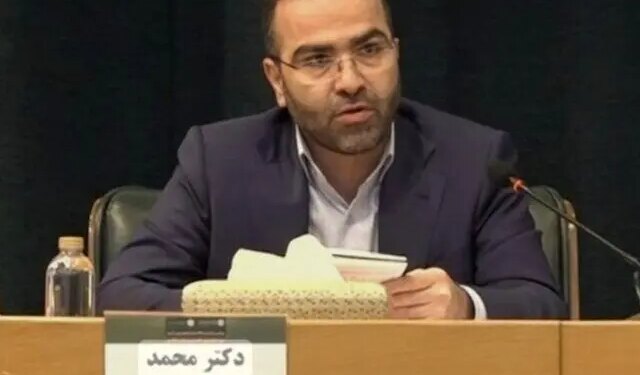According to the report of Economy 100, while referring to the conditions at the beginning of 1402, Shirijian stated: Last year was one of the few years that the central bank announced and introduced its specific monetary policy program in the field of Rial, currency and credit under the title of economic stabilization policy.
He continued: The reason for choosing the aforementioned political approach was that during the four years ending in 1401, i.e. from 1397 to 1401, we encountered a series of events in the political and economic fields that led to a decline in trust and intensified negative expectations among the public and activists. It became economical. Therefore, this four-year time period was accompanied by a series of turbulences and instabilities in macroeconomic variables and caused the macroeconomic variables including liquidity growth rate, monetary base growth rate, exchange rate, inflation rate, and economic growth rate to deviate from the trend. long term stay away.
The official of the central bank explained why the economic stabilization policy was used and stated: The economic stabilization policy is actually the policy of the government's economic system. This means that the economic complex of the government with the aim of creating stability and effectively dealing with the short-term fluctuations of economic variables and also in order to make economic conditions more predictable for business owners, they came to the conclusion that based on a set of policies Provide the conditions for the inclination of economic variables towards long-term trends.
He added: The ultimate goal of these actions was to increase the confidence of economic activists and the general public in the macroeconomic policies of the country, especially the monetary policies that are adopted by the monetary policy authority, and the authority, regulatory function and The governance of the central bank should be improved in relation to the country's monetary, currency and credit policies and institutions. Based on this, the stabilization policy was adopted in a two-year period and perspective. Last year was actually the first year of implementation of this policy and this policy will continue in 1403.
The economic vice president of the central bank continued to explain the framework and axes of the economic stabilization policy and stated in this regard; The first axis of this policy is the issue of liquidity control and management, because according to the opinions of economic experts, this variable has an extremely significant effect on inflation in the medium and long term. The second axis of that category was organizing and strengthening the governance and regulation of the central bank on the currency market because this variable has a significant impact on inflation in the short term through the channel of expectations and in the medium term through the increase in the cost of producers. The third axis of this program is the issue of organizing and enhancing the central bank's supervision and regulatory power over the banking network, and the fourth axis is the regulation of financial relations between the government and the central bank, and finally the axis of strengthening communication policies in the field of monetary policy with the general public and improving diplomacy. is the currency of the central bank; The tip of the arrow is the synergy of all these axes in order to strengthen the governance and accreditation of the central bank's policies.
Shirijian evaluated one of the most important achievements of the central bank last year in the field of liquidity control and management and said: One of the objectives set by the monetary policy authority was related to the growth rate of liquidity in such a way that the targeted rate of this variable in this Last year, the bank had set targets in the field of economic variables. Therefore, the target rate for liquidity growth last year was set at 25%, and fortunately, by using a set of monetary policy tools that will be mentioned below; In practice, the liquidity growth rate at the end of last year reached 24.3%, which not only achieved the intended goal, but also improved by 0.7% compared to the target, and compared to the beginning of last year, this variable increased to The amount decreased by 8.8 percent. It should be noted that the average growth of the country's liquidity in the 20-year, 25-year and 60-year periods ending in 1402 is 28.5%, 28.2% and 25.7%, respectively, and these figures indicate that Realized liquidity growth in the past year has been significantly better than the long-term average.
He pointed out: In the area of liquidity control and management, the central bank used a set of monetary policy tools, and contrary to what is thought that this bank has controlled liquidity only through the policy tool of controlling a certain amount of banks' balance sheets; This was not the case and this was only one of the most important policy tools of the Central Bank last year.
He reminded: In addition to using this tool, the monetary policy maker last year used other tools such as legal deposit, revision of interest rate vectors, political interest rate and interest rate corridor, regulation of financial relations between the government and the central bank, and the use of the account. The treasury unit adjusted the liquidity required by the interbank market through repo and reverse repo operations with the aim of adjusting the interest rate of the interbank market in the designated corridor, as well as using new monetary policy tools such as special certificates of deposit and deposit bonds, the liquidity growth rate achieve within the set target range.
The economic vice president of the central bank said regarding the policy of controlling the amount of balance sheets of banks: the policy of controlling the amount of balance sheets of banks has the nature of macroprudential policy rather than monetary policy tools. Because, in general, the capital situation of the country's banking network is far from the standard and desirable capital adequacy ratio of the central bank. Therefore, by using this macro-precautionary policy, we not only managed the intermediation operations of the banking network funds, especially the non-performing banks, and controlled the aggravation of the imbalance of the banks' balance sheets, but also, this policy led to the realization of the positive side effect of creating the endogenous liquidity of the banks. became.
He emphasized: The central bank is aware that the liquidity control policy can have effects on the financing of companies and somehow make companies face financing bottlenecks, therefore, the use of new tools to finance working capital and projects has put the development and creation of economic enterprises on the agenda; To provide working capital, which constitutes 62% of the total share of facilities paid to the economic sectors and about 82% of the share of facilities paid to the industry and mining sector; It has planned on the method of chain financing and in the form of using tools such as step bonds, electronic bills of exchange, factoring and other accrual tools, and for financing development and creation projects, it has also used the method of issuing special certificates of deposit in order to equip Resources and financing of projects are on the agenda; Of course, last year we also used the special deposit certificate tool to finance 200 thousand billion tomans of working capital of companies. All in all, these kinds of tools provide specific resources for financing productive economic sectors and the deviation of resources from these sectors is minimal.
He called the effects of these measures evident in the economic growth of 1401 and 1402 and said: Based on this, we had positive and favorable economic growth in various sectors of oil, industry, services and agriculture, and we must use this policy in the field of financing for 1403. We will also continue.
This official in the central bank said about the target setting of the central bank in the field of liquidity: For the year 1403, the target setting that we have considered in the field of liquidity growth rate is an average rate of 23%, and for that, the numerical range is positive. We also considered negative two percent, which can fluctuate according to the volume of demand for cash and the conditions and requirements of the country's macro economy.
Shirijian stated that last year we witnessed the improvement of economic variables, especially in the field of monetary variables and the realization of all the goals considered by the monetary policy maker, and said: Apart from the desired realization of the set goals in relation to the growth rate of liquidity, which is mentioned became; The point-to-point inflation rate of the consumer price index decreased by 26.2% at the end of last year compared to the beginning of the year and was at a suitable level of the 30% channel. Also, about the producer price index inflation, which shows its effect on the consumer price index with a time delay, this rate decreased from 40.7% at the beginning of the year to 24.5% at the end of the year, which means that this figure is 16 It has decreased by 2%.
He noted: Regarding the monetary base, this rate decreased from 45% to 29.4%. For the year 1403, these policies will be continued using a set of monetary policy tools so that we can direct inflation to the optimal and targeted level according to the average and long-term trend of this variable. Because inflation is a variable that, if it has unfavorable fluctuations, has a strong negative impact on the predictability of economic activities and production.
Shirijian stated that it is necessary to pay attention to the fact that our financing sources, including cash and credit sources, should be directed to productive sectors of the economy as much as possible. spill over to productive economic sectors; It will definitely lead to the efficient allocation of resources, added value and higher economic growth, and if the volume and liquidity exchanges towards non-productive sectors are desired, it will lead to the development of speculative activities, price turbulence in the asset market and intensifying inflation.
He continued: This is also achieved through financing methods in which from the stage of equipping to the allocation of resources for a specific project, including chain financing tools and special deposit certificates, are effectively achieved. Therefore, the central bank's main focus is to maximize the liquidity and credit resources of the banking network in 1403 to the economically productive sectors. But as soon as these resources are diverted and move towards non-productive sectors, then it will show its spillover effects on increasing the general level of prices.
Referring to the central bank's recommendation to the banking network to move towards the use of accrual instruments for financing companies, the vice president of economics of the central bank stated: We tried to increase the attractiveness of these instruments. For example, last year, we had very good approvals in the Money and Credit Council regarding Oruq Gam. For example, it was approved that the possibility of discounting these bonds for the benefit companies of these bonds in a chain in the first ring 25%, the second ring 50% and the third ring onwards up to 75%, and therefore if economic companies need financing have urgent, in this way, they can start financing their urgent cash.
He added: For the use of Gam bonds, we have also defined government expenses, that is, the holders of Gam bonds can use up to 20% of these bonds to repay their government debts, such as tax debts, insurance debts, customs duties and taxes, mineral rights, payment of expenses. water, electricity, gas and feed costs of refineries and petrochemicals; By adopting a set of these measures, we tried to increase the attractiveness of using these bonds for economic enterprises; Besides, another advantage of financing using this tool and other chain financing tools and special certificates of deposit is that their financing is done in a much shorter period of time and at a lower cost than obtaining facilities. There is no longer any need to wait and stand in the allocation queue to get loans from banks. If the banks move towards the use of accrual instruments, their resources will be minimally involved and they will finance a production chain at the same time and benefit from the fee income of its issuance and transfer, and from the perspective of macroeconomics. Also, endogenous liquidity creation by banks does not happen.
The economic vice president of the central bank called strengthening the supervision and organization of the banking network one of the pillars of the economic policies of the central bank and said: “Last year, we liquidated three unsustainable unsustainable credit institutions, and we will continue to strengthen the policy of organizing the banking network for 2014 as well.” . Based on the surveys, our banks are classified as healthy, unhealthy, unrevivable, and unhealthy, revivable banks. Of course, most of our banking network, even if they are not among healthy banks, they are in the category of banks that can be revived, and last year, with their help, rehabilitation programs were given to these banks, and the monitoring of these programs continues. These programs are in the form of receivables collection, capital increase, reduction of non-current receivables ratio and sale of frozen and non-banking assets, and this program will continue strongly for the year 1403.
In the end, he said about the current year's plans: The year 1403 was named by the supreme leader of the revolution as “the year of production leap with people's participation”. Therefore, considering the burden on the banking system in financing the country, it must play a serious role in this field. In addition to this, this year is the first year of implementation of the 7th Development Plan and Central Bank Program Law. Based on this, we will have reform plans for the banking network according to the capacities available in the Central Bank Law and the 7th Development Plan. But the main point is that sector and project priorities in the country should be determined by the real sectors and the country's planning system so that the country's limited financial resources in foreign currency and Rials are allocated to these driving priorities with the aim of maximizing the economic added value. It is necessary to avoid unplanning and scattering in the allocation of the country's limited financial resources; The desired realization of this matter should be done by the country's planning system.


















گفتگو در مورد این post